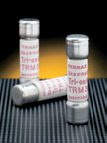

Ampacity The current a conductor can carry continuously without exceeding its temperature rating. Ampacity is a function of cable size, insulation type and the conditions of use.
Ampere Rating The continuous current carrying capability of a fuse under defined laboratory conditions. The ampere rating is marked on each fuse. Class L fuses and E rated fuses may be loaded to 100% of their ampere rating. For all other fuses, continuous load current should not exceed 80% of fuse ampere rating.
Available Fault Current The maximum short circuit current that can flow in an unprotected circuit.
Bolt-in Fuse A fuse which is intended to be bolted directly to bus bars, contact pads or fuse blocks.
Contacts The external live parts of the fuse which provide continuity between the fuse and the balance of the circuit. Also referred to as ferrules, blades or terminals.
Coordination The use of overcurrent protective devices which will isolate only that portion of an electrical system which has been overloaded or faulted. (See Selectivity.)
Current-Limiting Fuse A fuse which will limit both the magnitude and duration of current flow under short circuit conditions.
Current-Limiting Range The available fault currents a fuse will clear in less than 1/2 cycle, thus limiting the actual magnitude of current flow.
Dual Element Fuse Often confused with time delay, dual element is a term describing fuse element construction. A fuse having two current responsive elements in series.
Element A calibrated conductor inside a fuse which melts when subjected to excessive current. The element is enclosed by the fuse body and may be surrounded by an arc-quenching medium such as silica sand. The element is sometimes referred to as a link.
Fault An accidental condition in which a current path becomes available which by-passes the connected load.
Fault Current The amount of current flowing in a faulted circuit.
Fuse An overcurrent protective device containing a calibrated current carrying member which melts and opens a circuit under specified overcurrent conditions.
I²t (Ampere Squared Seconds) A measure of the thermal energy associated with current flow. I2t is equal to (lRMS)2 x t, where t is the duration of current flow in seconds.
Clearing I²t The total I2t passed by a fuse as the fuse clears a fault, with t being equal to the time elapsed from the initiation of the fault to the instant the fault has been cleared.
Melting I²t The minimum I2t required to melt the fuse element.
Interrupting Rating (Abbreviated I.R.) The maximum current a fuse can safely interrupt. Some special purpose fuses may also have a “Minimum Interrupting Rating”. This defines the minimum current that a fuse can safely interrupt.
Kiloamperes (Abbreviated kA) 1,000 amperes.
Limiter or Back-up Fuse A special purpose fuse which is intended to provide short circuit protection only.
Overcurrent Any current in excess of conductor ampacity or equipment continuous current rating.
Overload The operation of conductors or equipment at a current level that will cause damage if allowed to persist.
Peak Let-Thru Current (lp) The maximum instantaneous current passed by a current- limiting fuse when clearing a fault current of specified magnitude.
Rejection Fuse Block A fuse block which will only accept fuses of a specific UL class.
Rejection A safety feature intended to prevent the insertion of a fuse with an inadequate voltage or interrupting rating.
Rejection Fuse A current-limiting fuse with high interrupting rating and with unique dimensions or mounting provisions.
Renewable Fuse A fuse which can be restored for service by the replacement of its element.
Renewable Element or Link The field-replaceable element of a renewable fuse. Also referred to as a renewal link.
Selectivity A main fuse and a branch fuse are said to be selective if the branch fuse will clear all overcurrent conditions before the main fuse opens. Selectivity is desirable because it limits outage to that portion of the circuit which has been overloaded or faulted. Also called selective coordination.
Semiconductor Fuse An extremely fast acting fuse intended for the protection of power semiconductors. Sometimes referred to as a rectifier or ultra fast fuse.
Short Circuit Excessive current flow caused by insulation breakdown or wiring error.
Threshold Current The minimum available fault current at which a fuse is current limiting.
Time Delay Fuse A fuse which will carry an overcurrent of a specified magnitude for a minimum specified time without opening. The specified current and time requirements are defined in the UL/CSA/NOM 248 fuse standards.
Voltage Rating The maximum voltage at which a fuse is designed to operate. Voltage ratings are assumed to be for AC unless specifically labeled as DC.
To learn more about fuses, or about any other products or services of IBT Electrical Group, please contact us.





